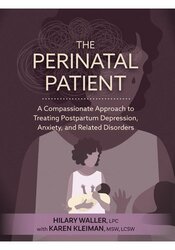What Are Perinatal Mood and Anxiety Disorders?

When we talk with women about what they fantasized becoming a mother would feel like, most expected to feel overwhelmed in both wonderful and frightening ways. This expectation is reasonable. Becoming a mother does welcome women into a world of both extraordinary wonder and intense fear. However, few mothers expect to feel more disappointed, helpless, and hopeless than anyone else could possibly understand, let alone help.
In turn, when the fear that something is wrong descends upon them, mothers frantically look for ways to help themselves ŌĆō desperate to maintain the illusion that everything is okay. At first, this is not a bad thing. Mild perinatal distress responds well to self-help and social support. However, when the distress becomes too intense and prolonged, it can move into the realm of perinatal mood and anxiety disorders.
In this straight from The Perinatal Patient, we explore perinatal mood and anxiety disorders in detail and provide insight into the unique symptom profile for each type of disorder. As a provider, consider how you will convey the information in this infographic to your patients. You may provide them with relevant worksheets, develop talking points or a class from its content, or even decide to share this infographic in its entirety.
As a reminder, this and do not serve as diagnostic tools, but they do aim to empower providers to help mothers in distress as well as empower mothers to talk to someone who can help them sort out what they are experiencing.
In turn, when the fear that something is wrong descends upon them, mothers frantically look for ways to help themselves ŌĆō desperate to maintain the illusion that everything is okay. At first, this is not a bad thing. Mild perinatal distress responds well to self-help and social support. However, when the distress becomes too intense and prolonged, it can move into the realm of perinatal mood and anxiety disorders.
In this straight from The Perinatal Patient, we explore perinatal mood and anxiety disorders in detail and provide insight into the unique symptom profile for each type of disorder. As a provider, consider how you will convey the information in this infographic to your patients. You may provide them with relevant worksheets, develop talking points or a class from its content, or even decide to share this infographic in its entirety.
As a reminder, this and do not serve as diagnostic tools, but they do aim to empower providers to help mothers in distress as well as empower mothers to talk to someone who can help them sort out what they are experiencing.
Digital Seminar:
Postpartum Depression & Related Disorders: Clinical Strategies to Identify and Treat Parents Who Are Suffering in Silence
Postpartum Depression & Related Disorders: Clinical Strategies to Identify and Treat Parents Who Are Suffering in Silence

ItŌĆÖs not a topic that comes up at play groups or over coffee. Instead, new parents suffer quietly, engulfed in shame and secrecy, afraid to dispel the ever-present myths about parenthood - ŌĆ£everything is perfect,ŌĆØ ŌĆ£I love being a parent,ŌĆØ and ŌĆ£this is the happiest time of my life.ŌĆØ
Watch this compelling one-day seminar and gain tools to intervene during a critical period that does not offer the luxury of time. Postpartum parents are exceptionally vulnerable, as are their infants who are fully dependent on them. This seminar is a must-attend for any professional working with pregnant or postpartum parents.
Watch this compelling one-day seminar and gain tools to intervene during a critical period that does not offer the luxury of time. Postpartum parents are exceptionally vulnerable, as are their infants who are fully dependent on them. This seminar is a must-attend for any professional working with pregnant or postpartum parents.
The Perinatal Patient

Caught between worrying about how she feels and desperately working to portray the image of a good mother, a perfect mother, a mother who knows what sheŌĆÖs doing, the postpartum woman in distress is more likely to choose silence or minimization over disclosure.
She will allow her suffering ŌĆō her dark mood, scary intrusive thoughts, intense anxiety, excessive monitoring of the baby, feelings of inadequacy, grief over lost independence, thoughts of harming herself or the baby, and even delusions and hallucinations ŌĆō to fly under the radar in exchange for a calm and collected exterior. Even if sheŌĆÖs worried about how she feels. Even if she and her baby are in danger.
The Perinatal Patient seeks to change that. Co-written by world-renowned maternal mental health expert Karen Kleiman and her highly accomplished mentee at The Postpartum Stress Center, Hilary Waller, this book offers revolutionary, compassionate guidance into the nuanced assessment and treatment of mental health symptoms postpartum ŌĆō a critical period that does not offer the luxury of time.
She will allow her suffering ŌĆō her dark mood, scary intrusive thoughts, intense anxiety, excessive monitoring of the baby, feelings of inadequacy, grief over lost independence, thoughts of harming herself or the baby, and even delusions and hallucinations ŌĆō to fly under the radar in exchange for a calm and collected exterior. Even if sheŌĆÖs worried about how she feels. Even if she and her baby are in danger.
The Perinatal Patient seeks to change that. Co-written by world-renowned maternal mental health expert Karen Kleiman and her highly accomplished mentee at The Postpartum Stress Center, Hilary Waller, this book offers revolutionary, compassionate guidance into the nuanced assessment and treatment of mental health symptoms postpartum ŌĆō a critical period that does not offer the luxury of time.
Meet the Experts:
Hilary Waller, MS, LPC, is a psychotherapist who specializes in the treatment of perinatal mood and anxiety disorders. She is the director of education and programming at The Postpartum Stress Center outside of Philadelphia, which was founded by renowned perinatal expert Karen Kleiman and was listed in Philly Magazine as a ŌĆ£Center of ExcellenceŌĆØ for maternal/fetal care in 2008. In addition to providing direct care services to individuals, couples, and groups at the center, Hilary serves as an instructor with Karen Kleiman, providing a quarterly 12 CE hour postgraduate advanced training for clinicians across the US and abroad who want to specialize in treating the perinatal population. She conducts workshops and trainings for maternal mental healthcare providers as well as non-clinical staff working with the perinatal population. Hilary completed her masterŌĆÖs degree in counseling psychology from Holy Family University in 2013. She is deeply honored to support new patients.
Learn more about her educational products, including upcoming live seminars, by clicking here.
Karen Kleiman, MSW, LCSW, is a well-known international maternal mental health expert with over thirty-five years of experience. As an advocate and author of several groundbreaking books on postpartum depression and anxiety, her work has been featured worldwide within the mental health community and beyond for decades. In 1988, Karen founded The Postpartum Stress Center, the premier treatment and training facility for prenatal and postpartum depression and anxiety. In 2022, she founded The Karen Kleiman Training Center, LLC, dedicated to the advancement of clinical expertise and therapeutic strategies for the treatment of perinatal mood and anxiety disorders. All advanced trainings are heavily influenced by The Art of Holding Perinatal Women in DistressŌäó model of intervention she developed in 2017.
Learn more about her educational products, including upcoming live seminars, by clicking here.
Learn more about her educational products, including upcoming live seminars, by clicking here.
Karen Kleiman, MSW, LCSW, is a well-known international maternal mental health expert with over thirty-five years of experience. As an advocate and author of several groundbreaking books on postpartum depression and anxiety, her work has been featured worldwide within the mental health community and beyond for decades. In 1988, Karen founded The Postpartum Stress Center, the premier treatment and training facility for prenatal and postpartum depression and anxiety. In 2022, she founded The Karen Kleiman Training Center, LLC, dedicated to the advancement of clinical expertise and therapeutic strategies for the treatment of perinatal mood and anxiety disorders. All advanced trainings are heavily influenced by The Art of Holding Perinatal Women in DistressŌäó model of intervention she developed in 2017.
Learn more about her educational products, including upcoming live seminars, by clicking here.



